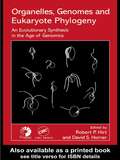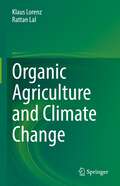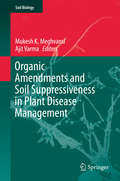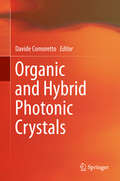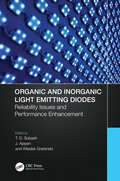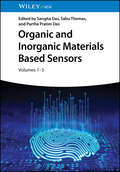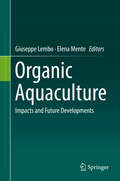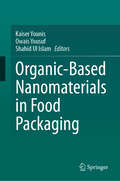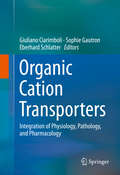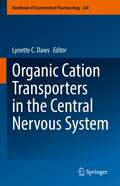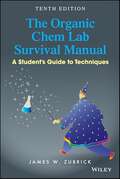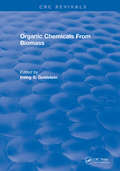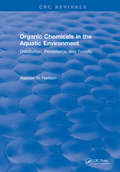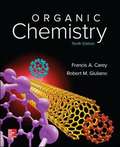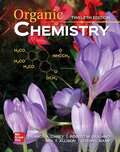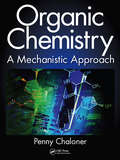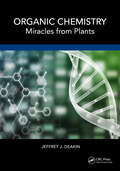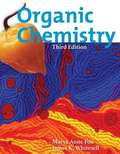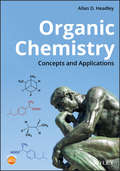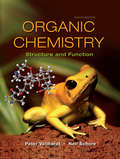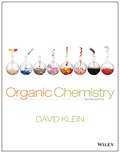- Table View
- List View
Organelles, Genomes and Eukaryote Phylogeny: An Evolutionary Synthesis in the Age of Genomics
by Robert P. Hirt David S. HornerThe recent revolution in molecular biology has spread through every field of biology including systematics and evolution. Researchers can now analyze the genomes of different species relatively quickly, and this is generating a great deal of data and theories about relationships between taxa as well as how they originated and diversified. Org
Organic Agriculture and Climate Change
by Klaus Lorenz Rattan LalThis book will collate, review and synthesize information on how Organic Agriculture (OA) practices affect and are affected by climate change, in comparison to the more widely used conventional agricultural practices. Pros and cons of OA practices will be discussed separately for croplands, pasture lands, mixed livestock cropping systems, vegetable fields, fruit and tree orchards, and vineyards. The book concludes with an overview on how conventional and OA practices can be prudently and discriminately combined to identify and adopt climate-resilient agro-ecosystems under site-specific conditions.
Organic Amendments and Soil Suppressiveness in Plant Disease Management
by Mukesh K. Meghvansi Ajit VarmaThis book provides a timely review of concepts in plant disease management involving microbial soil suppressiveness and organic amendments. Topics discussed include the impact of suppressive soils on plant pathogens and agricultural productivity, the enhancement of soil suppressiveness through the application of compost and the development of disease suppressive soils through agronomic management. Further chapters describe diseases caused by phytopathogens, such as Pythium, Fusarium and Rhizoctonia, interaction of rhizobia with soil suppressiveness factors, biocontrol of plant parasitic nematodes by fungi and soil suppressive microorganisms.
Organic and Carbon Gels: From Laboratory Synthesis to Applications (Advances in Sol-Gel Derived Materials and Technologies)
by Ana Arenillas J. Angel Menéndez Gudrun Reichenauer Alain Celzard Vanessa Fierro Francisco José Maldonado Hodar Esther Bailόn-Garcia Nathalie JobThis expert volume provides specialized coverage of the current state of the art in carbon gels. Carbon gels represent a promising class of materials with high added value applications and many assets, like the ability to accurately tailor their structure, porosity, and surface composition and easily dope them with numerous species. The ability to obtain them in custom shapes, such as powder, beads, monoliths, or impregnated scaffolds opens the way towards numerous applications, including catalysis, adsorption, and electrochemical energy storage, among others. Nevertheless, it remains a crucial question as to which design synthesis and manufacturing processes are viable from an economic and environmental point of view. The book represents the perspectives of renowned specialists in the field, specially invited to conduct a one-day workshop devoted to carbon gels as part of the 19th International Sol-Gel Conference, SOL-GEL 2017, held on September 3rd, 2017 in Liège, Belgium.Addressing properties and synthesis through applications and industry outlook, this book represents essential reading for advanced graduate students through practicing researchers interested in these exciting materials.
Organic and Hybrid Photonic Crystals
by Davide ComorettoThis book provides a multidisciplinary perspective (ranging from chemistry to physics and biology) of the current research and applications of organic and hybrid photonic crystals. The authors detail the chemical and physical tools used to develop organic photonic crystals, explain methods for engineering new nano-structures, and propose novel physical phenomena or technological applications based on such materials. Organic and Hybrid Photonic Crystal lasers, sensors, photovoltaic devices and stimuli responsive devices are discussed.
Organic and Inorganic Light Emitting Diodes: Reliability Issues and Performance Enhancement
by T. D Subash J Ajayan Wladek GrabinskiThis book covers a comprehensive range of topics on the physical mechanisms of LEDs (light emitting diodes), scattering effects, challenges in fabrication and efficient enhancement techniques in organic and inorganic LEDs. It deals with various reliability issues in organic/inorganic LEDs like trapping and scattering effects, packaging failures, efficiency droops, irradiation effects, thermal degradation mechanisms, and thermal degradation processes. Features: Provides insights into the improvement of performance and reliability of LEDs Highlights the optical power improvement mechanisms in LEDs Covers the challenges in fabrication and packaging of LEDs Discusses pertinent failures and degradation mechanisms Includes droop minimization techniques This book is aimed at researchers and graduate students in LEDs, illumination engineering, optoelectronics, and polymer/organic materials.
Organic and Inorganic Materials Based Sensors, 3 Volumes
by Sangita Das Sabu Thomas Partha Pratim DasOrganic and Inorganic Materials Based Sensors A three-volume comprehensive overview of the development and applications of various novel potent molecular sensor frameworks In Organic and Inorganic Materials Based Sensors (3 Volume Set), a team of distinguished researchers delivers an interdisciplinary presentation of the engineering of high-performance biopolymer-based bio-nanocomposites, as well as strategies for the use of various molecules in the detection of environmentally important guest analytes. This three-volume book explores the most relevant technological developments in nanomaterials sensors and offers a broad and comprehensive overview of cutting-edge research on advanced materials in the fast-moving sensors industry. The authors explain the science behind nanomaterials for environmental remediation as well as the components and ingredients of the relevant materials. Readers will also find: Thorough introductions to sensory devices, polymer-based nano-biomaterials, and opto-electrochemical devices Comprehensive explorations of metal–organic frameworks, organic sensors, and organic–inorganic composite semiconductor sensors Practical discussions of vapochromic and vapoluminescent sensors Fulsome treatments of sensor ecosystems for health self-monitoring, including discussions of diabetes management Perfect for materials scientists, mechanical engineers, and analytical chemists, Organic and Inorganic Materials Based Sensors will also benefit inorganic and organic chemists, robotics engineers, and professionals working in the sensor industry.
Organic Aquaculture: Impacts and Future Developments
by Giuseppe Lembo Elena MenteThis book addresses, reviews and evaluates key themes in organic aquaculture and is set out to show how these relate to the challenges and bottlenecks for a responsible organic aquaculture production in Europe. The key themes reflect the main challenges facing the organic aquaculture industry: guarantee and certification system, nutrition, reproduction, production system design and animal welfare. In addition, it assesses the impact of new and future potential development of new knowledge to update and modify the criteria and standards for organic aquaculture. Organic aquaculture is an alternative production approach driven by the growing interest in sustainable utilization of resources. It is rightly viewed as an important contributor to the economy and to the well-being and health of communities. This work will contribute to the scientific knowledge that needs to strengthen effective organic aquaculture. The collation of information on research and data will be of applied value to researchers, university students, end users and policy authorities in the EU and worldwide.
Organic-Based Nanomaterials in Food Packaging
by Shahid Ul Islam Kaiser Younis Owais YousufThe use of nanomaterials in food packaging is a rapidly advancing area with massive potential for increasing shelf life and improving the safety of food products. Up to this point there has not been a suitable reference work covering the basic modules of organic-based nanomaterials in food packaging. This work documents organic nanomaterials and their synthesis; Characterization, composition and structure of organic nanomaterials; Mechanical properties of organic nanomaterials; Cellulose, Starch, Chitosan, protein and conjugated organic nanomaterials for food packaging plus nano emulsions for edible coating and the overall safety and regulatory aspects of organic nanomaterials. Organic-Based Nanomaterials in Food Packaging is designed to serve researchers, students in food science and technology and food processing, and food industry professionals as well. With chapters covering the synthesis of organic nanomaterials, characterization, composition and structure of organic nanomaterials, mechanical properties and an overview of organic-based nanomaterials use in food packaging, cellulose, starch, chitosan and protein -based nanomaterials are covered. Further chapters focus on conjugated organic nanomaterials, nano emulsions for edible coating and the safety and regulatory issues of organic nanomaterials. For researchers, students and the professionals looking for a full and up-to-date overview of organic based nanomaterials in food packaging, this book serves as an excellent source.
Organic Bionics
by Gordon G. Wallace Michael Higgins Simon Moulton Robert M.I. KapsaThe first reference on this emerging interdisciplinary research area at the interface between materials science and biomedicine is writtenby pioneers in the field, who address the requirements, current status and future challenges. Focusing on inherently conducting polymers,carbon nanotubes and graphene, they adopt a systematic approach, covering all relevant aspects and concepts: synthesis and fabrication,properties, introduction of biological function, components of bionic devices and materials requirements. Established bionic devices, such asthe bionic ear are examined, as are emerging areas of application, including use of organic bionic materials as conduits for bone re-growth,spinal cord injury repair and muscle regeneration. The whole is rounded off with a look at future prospects in sustainable energy generation and storage.Invaluable reading for materials scientists, polymer chemists, electrotechnicians, chemists, biologists, and bioengineers.
Organic Cation Transporters
by Giuliano Ciarimboli Sophie Gautron Eberhard SchlatterThis innovative text explores the cellular transport of organic cations, from functional and structural properties to pharmacological implications and psychiatric developments. The authoritative chapters introduce organic cation transporters and then proceed to discuss their mechanisms such as binding of substrates and inhibitors; their drug dispositions and toxicity; their relationships to genetic and pathophysiological variability; and their roles in endocrine, metabolic, and neurological systems. The final chapters delve into the use of animal models for the study of organic cation transporter function and their possible use in environmental cycling of pharmaceutical residues. This comprehensive volume unites integrative transporter physiology with structural and molecular biology, genetics, pharmacology and pathophysiology, offering a holistic approach to utilizing this novel technique in physiological contexts. It will prove invaluable reading for researchers and students in various areas of integrative, organ, cell and molecular physiology as well as pharmacologists and neurologists.
Organic Cation Transporters in the Central Nervous System (Handbook of Experimental Pharmacology #266)
by Lynette C. DawsRapidly growing interest in the role of organic cation transporters (OCTs) and plasma membrane monoamine transporter (PMAT) in central monoamine homeostasis makes this book especially timely, given its thematic alignment with the role of OCTs and PMAT in CNS. This book discusses latest insights into the field laying an emphasis on health, disease and therapeutics. The chapter, “General Overview of Organic Cation Transporters in Brain”, of this book is available open access under a CC BY 4.0 license at link.springer.com
The Organic Chem Lab Survival Manual: A Student's Guide to Techniques
by James W. ZubrickWritten for the laboratory that accompanies the sophomore/junior level courses in Organic Chemistry, Zubrick provides students with a valuable guide to the basic techniques of the Organic Chemistry lab. The book will help students understand and practice good lab safety. It will also help students become familiar with basic instrumentation, techniques and apparatus and help them master the latest techniques such as interpretation of infrared spectroscopy. The guide is mostly macroscale in its orientation.
Organic Chemicals From Biomass
by Irving S. GoldsteinThe biomass emphasis in on material of terrestrial plant origin, although principles are directly transferable to aquatic plants with similar components. Products of animal origin are not included. Since animal fats and oils are not considered, it seemed logical to exclude vegetable oils as well. Biomass emphasis is on material of terrestrial plant origin, although the principles are directly transferrable to aquatic plants with similar components.
Organic Chemicals in the Aquatic Environment: Distribution, Persistence, and Toxicity
by Alasdair H. NeilsonOrganic Chemicals in the Aquatic Environment draws from the author's experience with a variety of problems dealing with the fate, distribution, and toxicity of organic compounds in the aquatic environment. It discusses the basic issues of chemical analysis, distribution, persistence, and ecotoxicology, with an emphasis on microbial reactions. The necessary input and the difficulties of achieving a rigorous synthesis of the various elements are illustrated with specific examples. The book includes a wide range of structurally diverse compounds as illustration and presents a mechanistic approach to biodegradation and biotransformation. The final chapter addresses the issue of environmental hazard assessment and constructs a strategy for carrying it out.
Organic Chemicals in the Environment: Mechanisms of Degradation and Transformation, Second Edition
by Alasdair H. Neilson Ann-Sofie AllardAddressing the persistent environmental threat of organic chemicals with a fresh approach to degradation and transformation processes, Organic Chemicals in the Environment: Mechanisms of Degradation and Transformation, Second Edition examines a wide range of compounds as well as abiotic and microbiological reactions mediated by microorganisms
Organic Chemistry: 8th Edition
by Paula Yurkanis BruiceFor courses in Organic Chemistry (2-Semester) Paula Bruice’s presentation in Organic Chemistry, Eighth Edition provides mixed-science majors with the conceptual foundations, chemical logic, and problem-solving skills they need to reason their way to solutions for diverse problems in synthetic organic chemistry, biochemistry, and medicine. The Eighth Edition builds a strong framework for thinking about organic chemistry by unifying principles of reactivity that students will apply throughout the course, discouraging memorization. With more applications than any other textbook, Dr. Bruice consistently relates structure and reactivity to what occurs in our own cells and reinforces the fundamental reason for all chemical reactions—electrophiles react with nucleophiles. New streamlined coverage of substitution and elimination, updated problem-solving strategies, synthesis skill-building applications and tutorials guide students throughout fundamental and complex content in both the first and second semesters of the course. Also Available with MasteringChemistry. MasteringChemistry from Pearson is the leading online homework, tutorial, and assessment system, designed to improve results by engaging readers before, during, and after class with powerful content. Instructors ensure readers arrive ready to learn by assigning educationally effective content before class, and encourage critical thinking and retention with in-class resources such as Learning Catalytics™. Readers can further master concepts after class through traditional and adaptive homework assignments that provide hints and answer-specific feedback. The Mastering gradebook records scores for all automatically graded assignments in one place, while diagnostic tools give instructors access to rich data to assess readers understanding and misconceptions. Mastering brings learning full circle by continuously adapting to each student and making learning more personal than ever–before, during, and after class. Note: You are purchasing a standalone product; MasteringChemistry does not come packaged with this content. Students, if interested in purchasing this title with MasteringChemistry, ask your instructor for the correct package ISBN and Course ID. Instructors, contact your Pearson representative for more information.
Organic Chemistry
by Francis A. Carey Robert M. GiulianoOrganic Chemistry has been designed to meet the needs of the "mainstream," two-semester, undergraduate organic chemistry course. This best-selling text gives students a solid understanding of organic chemistry by stressing how fundamental reaction mechanisms function and reactions occur.
Organic Chemistry
by Francis A. Carey Robert M. Giuliano Neil Allison Susan BaneOrganic Chemistry has been designed to meet the needs of the two-semester, undergraduate organic chemistry course. This best-selling text gives students a solid understanding of organic chemistry by focusing on how fundamental reaction mechanisms function and reactions occur. The authors strive for students to have a deeper understanding of the physical concepts that underlie organic chemistry, and for them to have a broader knowledge of the role of organic chemistry in biological systems.
Organic Chemistry: A Mechanistic Approach
by Penny ChalonerOffering a different, more engaging approach to teaching and learning, Organic Chemistry: A Mechanistic Approach classifies organic chemistry according to mechanism rather than by functional group. The book elicits an understanding of the material, by means of problem solving, instead of purely requiring memorization. The text enables a deep unders
Organic Chemistry: Miracles from Plants
by Jeffrey John DeakinHuman benefit from the organic chemistry of plants is incalculable in terms of health, food, comfort and security. Indeed, the future well-being of humanity rests in significant measure upon a responsible relationship with the plant kingdom in order to re-establish balance in the Earth’s natural environmental systems.In a highly readable volume, Organic Chemistry: Miracles from Plants presents many fascinating points of entry to the organic chemistry of a wide range of crucially-important, naturally-occurring, chemical substances which are derived from plants.Features: Presents in a readable and accessible manner many fascinating points of entry to the organic chemistry of a wide range of crucially-important, naturally-occurring, chemical substances which are derived from plants. Key concepts in and knowledge of organic chemistry are reinforced. Highly-relevant and contemporary context stimulates learning in organic chemistry. Searching exercises and extension materials are provided at the end of every chapter each of which is amply illustrated. In a single source, this volume provides knowledge, challenge and valuable learning opportunity in chemistry, medicine, nutrition and the environmental sciences.
Organic Chemistry
by Marye Anne Fox James K. WhitesellOrganic Chemistry by Fox and Whitesell is the pioneer in the mechanistic approach. Now in its third volume, this classic and proven pedagogy provides a much better basis for students to retain a knowledge base and extend it to practical applications in other areas of science. The mechanistic approach groups chemical reactions according to how the sequence of changes occurs- their common mechanisms- rather than by functional groups (what category- alcohols, amines, alkenes, etc.). Where appropriate, the text subdivides information based on functional groups. The text covers ALL of basic organic chemistry in the first 14 chapters and reviews the reactions covered in these chapters in chapter 15 on multi-step synthesis. The text also contains extensive coverage of both industrial and biological polymers, and describes molecular basis for drug action.
Organic Chemistry: Concepts and Applications
by Allan D. HeadleyProvides an in-depth study of organic compounds that bridges the gap between general and organic chemistry Organic Chemistry: Concepts and Applications presents a comprehensive review of organic compounds that is appropriate for a two-semester sophomore organic chemistry course. The text covers the fundamental concepts needed to understand organic chemistry and clearly shows how to apply the concepts of organic chemistry to problem-solving. In addition, the book highlights the relevance of organic chemistry to the environment, industry, and biological and medical sciences. The author includes multiple-choice questions similar to aptitude exams for professional schools, including the Medical College Admissions Test (MCAT) and Dental Aptitude Test (DAT) to help in the preparation for these important exams. Rather than categorize content information by functional groups, which often stresses memorization, this textbook instead divides the information into reaction types. This approach bridges the gap between general and organic chemistry and helps students develop a better understanding of the material. A manual of possible solutions for chapter problems for instructors and students is available in the supplementary websites. This important book: • Provides an in-depth study of organic compounds with division by reaction types that bridges the gap between general and organic chemistry • Covers the concepts needed to understand organic chemistry and teaches how to apply them for problem-solving • Puts a focus on the relevance of organic chemistry to the environment, industry, and biological and medical sciences • Includes multiple choice questions similar to aptitude exams for professional schools Written for students of organic chemistry, Organic Chemistry: Concepts and Applications is the comprehensive text that presents the material in clear terms and shows how to apply the concepts to problem solving.
Organic Chemistry: Structure And Function
by K. Peter C. Vollhardt Neil SchoreWith authors who are both accomplished researchers and educators, Vollhardt and Schore’s Organic Chemistry takes a functional group approach with a heavy emphasis on understanding how the structure of a molecule determines how that molecule will function in chemical reactions. By understanding the connection between structure and function, students will better understand mechanisms and solve practical problems in organic chemistry.
Organic Chemistry
by David KleinThe textbook includes important concepts in Organic chemistry, complete with conceptual checkpoints that promote mastery of the concepts, and special emphasis is placed on skills development through Skill Builders to support these concepts.
